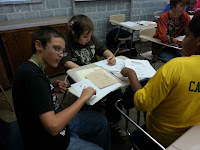Week 9 " Food Inc."
This week studnets began watching a documentary called "Food, Inc.". This movie is controversial and sparks much debate over bitechnology and food processing. Studnets were very engaged in this program and were begining to question where their food does in fact come from. We are also begingin to see some of the positives and negatives of using biotechnology on such a large scale in food production. We are going to have some very good debates next week after we are finished watching this. We will also continue research in the next few weeks about biotechnology in food production with some other informational sources. Eventually we will have an actual debate about biotechnology and food production.









.jpg)

.jpg)
.jpg)










